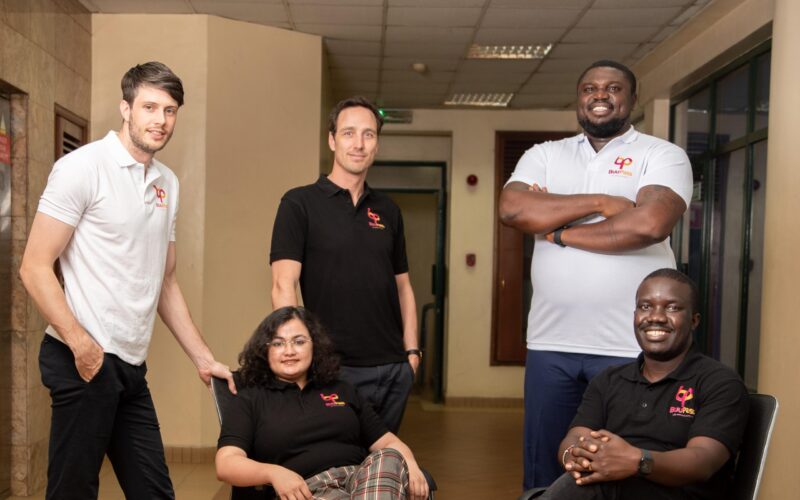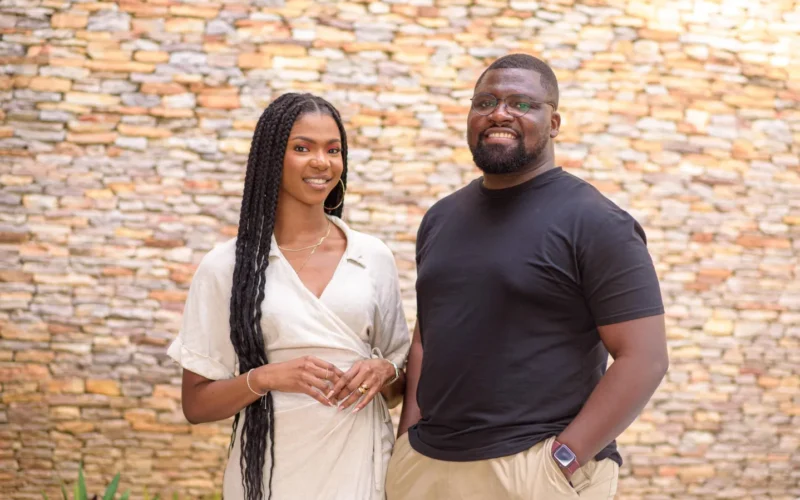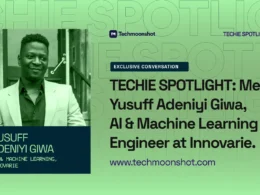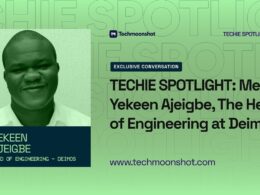For Joel Olawanle, the journey into tech began out of sheer curiosity — not with grand dreams of becoming a software engineer, but with the simple thrill of building something logical and seeing it come alive on the web. His first taste of code came while in school when he joined a local dev community called Inventors. There, he learned HTML, CSS, and PHP, and built his first real project — a platform where writers could publish and share e-books online. “At the time, I felt like a genius,” Joel recalls. That excitement, however, met a hard reality when the site, hosted on a free service, got hacked with malicious code. Without knowledge of security or access to reliable hosting, Joel eventually had to shut it down — but the lessons stuck.
His passion reignited in 2020 after attending OSCAFEST in Lagos just before the COVID lockdown. Witnessing young Nigerian developers contributing to global tools opened his eyes to the impact of open source and community. Determined not to waste the lockdown, Joel set a personal challenge: learn something new every week and write about it. He shared his posts on dev.to, and to his surprise, developers from India, the UK, and the US began engaging with his work — even thanking him for helping solve their bugs.
In this exclusive conversation, Joel Olawanle shares how a spark of curiosity led him into the world of coding, how documenting his learning journey during the COVID lockdown opened unexpected doors, and how he discovered a passion for technical writing that has shaped his career.
Can you share your origin story—how did you go from learning to code to becoming a technical writer and open-source contributor?
I got into coding out of curiosity. I didn’t have a big dream of being a software engineer. I just liked the idea of building something with logic and seeing it live on the web.
Before the COVID lockdown, I attended the first OSCAFEST in Lagos. That event really opened my eyes. I saw young people from Nigeria contributing to tools used globally. I left that event super motivated. I started following people I met there and others I discovered on Twitter.
When the lockdown happened, I decided I wasn’t going to waste time. I set a personal goal to learn and also write about anything I learned weekly. I posted everything on dev.to. Surprisingly, people from countries like India, the UK, and the US started engaging with my posts. Some even said I helped them fix bugs.
That was the first time I realized technical writing was a thing. Later, I saw a tweet saying companies pay technical writers. That’s when it clicked for me, I’d already been doing it. I applied for a few roles and got my first paid writing gig. That’s how my writing career started.
From there, I wrote for SaaS companies, tech blogs, and developer tools. Since technical writing is part of open source, it led me deeper into that space. I also started contributing to the OSCA community by running a chapter in school and getting involved in other open-source projects.
What was the first thing you ever built that made you feel like, “Yes, I’m really an engineer now”?
Haha. Back in school, I joined a dev community called Inventors. That’s where I first learned HTML, CSS, and PHP. The first real project I built was a platform where writers could publish and share their e-books online.
At the time, I felt like a genius. But I hosted it on some free service, and it didn’t take long before hackers found it and started injecting malicious code. I didn’t know anything about security back then. I tried to fix it, but eventually deleted the whole thing because I couldn’t afford proper hosting.
So yeah, at first, I felt like an engineer. Then reality hit, but I learned a lot from that.
How did your path lead to working at Kinsta, and what drew you to technical writing full-time?
Before Kinsta, I worked part-time with freeCodeCamp. That platform really helped put my name out there. Companies reached out because of my work on freeCodeCamp. That’s one of the cool things about open source: your work speaks for you.
One day I had a chat with someone on the team, and he mentioned Kinsta. I checked their careers page and saw they were hiring a full-time technical writer/editor. I applied and got the role.
What’s a day in your life like as a Technical Writer and Editor at Kinsta?
Honestly, no two days are the same.
Some days, I review outlines or drafts from freelance writers and agencies, making sure they’re solid before we add them to our content calendar. Other days, I’m writing technical articles myself. Sometimes I’m brainstorming BoFu (bottom-of-funnel) content ideas with the team (things that help our current users, win new customers, or support leads who are considering Kinsta).
There are also days I’m writing API changelogs or working on content to help agencies use our API better. Other times, I’m focused on product updates or sales enablement content (stuff that supports the business side of things).
What I enjoy most is how cross-functional the role is. I get to work with different teams, build small tools or demos, and write about them. It keeps things fresh, and I feel like I’m contributing to the company in a real way.
What’s the most underrated part of technical writing that people don’t talk about?
A lot of people think technical writing isn’t “technical” enough, that once you become a tech writer, you’ve stepped away from engineering. But that’s not true at all.
You actually touch a lot of tools and topics. Today you might be working with Astro, tomorrow it’s Docker, then Kubernetes, then maybe Node.js. You’re constantly switching contexts and picking up new things.
It’s not always about building products from scratch, but you still play a key role in making technical stuff clear, useful, and accessible. That’s its own kind of impact.
You contribute to freeCodeCamp and lead OSCA chapters—what do you enjoy most about being active in these spaces?
freeCodeCamp is an organization I really love. I deeply connect with its mission to help people learn to code for free. It’s crazy how the little things you do, like writing a tutorial or helping review a lesson, can impact thousands, sometimes millions, of people.
I get DMs on Twitter almost every other day from people saying, “Thank you for this post” or “Your guide helped me fix something.” Even with all the AI hype, there are still so many people, older folks and total beginners, who rely on these interactive courses to learn, and their feedback is always heartwarming.
Same with OSCA. I started a chapter from scratch while in school. I taught people about open source, hosted virtual sessions with guest speakers, and helped the community contribute to open source through writing and code. Some even went on to speak at major conferences or contribute to global projects.
What I enjoy most is seeing the impact. It’s not just numbers, it’s real people, real progress, and real stories.
What’s one thing you wish more devs understood about open source?
That it pushes you beyond your local bubble.
Open source gives you a chance to put your work out there, connect with people globally, and unlock opportunities that wouldn’t exist otherwise. It’s one of the fastest ways to grow, get noticed, and build something that lives beyond you.
Congrats on the launch of spidra.io! What is it, and what inspired you and your co-founders to build it?
Thank you! Spidra is a no-code tool for web automation and data extraction. Right now, it lets you scrape almost any website without writing code. It uses real browser actions and AI to handle things like dynamic pages, logins, and captchas. You just describe the data you want in a prompt, and it figures out how to get it.
The idea came out of pure frustration. My co-founders and I kept running into problems with existing scraping tools, especially when dealing with JavaScript-heavy sites or websites that needed human-like interaction.
So we built the tool we wished existed. One that behaves like a real user but also understands what data to pull using AI.
Right now, we’ve built the core engine. On top of that, we’re adding features like change tracking and scheduled scraping, so you can monitor websites and get updates sent to places like Slack or Discord.
It’s built for non-technical folks, founders, marketers, analysts, and anyone who needs web data without writing scripts or dealing with APIs. We’re still early, but the feedback so far has been really encouraging.
What has the journey of launching Spidra.io taught you that surprised you the most?
We haven’t officially launched yet. We just opened our waitlist. We want to bring in early testers to try the beta version, give feedback, report bugs, and help shape the product before going fully public.
What’s surprised me the most is how fast people get the value. Just from conversations, people immediately connect with the idea. That kind of reaction has been super validating.
What does success look like for Spidra.io in the next 6 to 12 months?
In the short term, we want to launch publicly within the next three months. From there, the goal is to keep building useful tools on top of our core engine, things that make it easier for people to get value without needing to learn scraping or automation.
In 12 months, success would look like thousands (and eventually millions) of users using Spidra to extract and monitor data. We also want to break into the global market and build serious infrastructure for making African data more accessible and useful.
You’ve written for several SaaS companies and blogs—how do you tailor technical content for different audiences?
I always start by figuring out who I’m writing for, what they already know and what they’re actually trying to learn.
If it’s beginners, I slow down, cut out the jargon, and explain things step by step. I use examples and analogies to make things click. But if it’s senior devs or engineers, I skip the basics and focus on what actually matters to them, edge cases, trade-offs, or how something works in production.
I also adapt to the company’s tone. Some want a friendly, casual voice, while others want it straight and professional. Either way, the goal is the same: make the content useful and clear.
What trends are you seeing in dev education and documentation that excite you?
One thing I like is how developer education is becoming more real-world-focused. Instead of just teaching theory, more platforms now use actual projects, real bugs, and practical tools people already use. That shift makes learning more relatable and useful.
For documentation, I’m excited about interactive elements like live code editors, API playgrounds, sandboxes, and the like. It’s a better experience when you can test things immediately without switching tabs or setting up an environment. It shortens the gap between “I read this” and “I tried it.”
Has AI changed how you write or plan content? If so, how?
Definitely, but I see AI as a writing assistant, not the writer.
I use it to brainstorm angles, draft outlines, and test ideas. Sometimes, I throw in a rough idea just to see how it reacts. It helps me spot gaps or overcomplications. It’s useful for summarizing documents, speeding up research, or checking for SEO intent when writing for content-heavy companies.
That said, AI doesn’t replace the human layer. It can’t 100% decide what’s worth saying or how to say it in a way that actually connects with people. That still takes judgment, experience, and knowing who you’re writing for to a large extent.
What advice would you give to someone who wants to combine coding, writing, and community leadership like you have?
Don’t wait to be an expert before you start sharing. Write as you learn. Teach what you just figured out, and people who are a few steps behind will find it super helpful.
Also, show up consistently in your community. Not as a “thought leader,” but as someone who contributes. Answer questions, help juniors, and document the stuff others ignore. Over time, people start to associate your name with value.
And most importantly, follow your curiosity. Not everything has to be part of some big personal brand. A small blog post or side project can open doors you didn’t even plan for.
What’s the most valuable skill outside of coding that’s helped you grow your career?
Writing, 100%. It’s not just about blog posts. It’s about being able to explain your thoughts clearly. Whether you’re writing a pull request, pitching an idea, or updating your team, good writing makes you way more effective.
It also helps you stand out, especially if you’re not the loudest person in the room.
What’s something you’ve changed your mind about in tech over the last few years?
I used to think the best technology and cleanest code always wins the most elegant solution.
But now I know that’s not true. What wins is what solves a real problem, is easy to use, well-documented, or just well-timed.
So these days, I care less about “perfect” architecture and more about whether what I’m building actually helps someone right now.
Coffee or tea—and how do you take it?
Coffee. I take it with a little milk and a bit of honey.
What’s your current favorite tech gadget or app, and why?
Right now, it’s Cursor. It’s like VS Code but with an actually useful AI built in. I use it to write, refactor, and explore code way faster. It feels like pair programming.
How do you unwind after a long work week?
I unplug. I go for long walks (with some random jogging in between), watch YouTube videos about things I’ll probably never do, and sometimes create videos on my YouTube channel.
If you weren’t in tech, what do you think you’d be doing?
Probably learning math, teaching it in the simplest form possible, maybe even chasing a PhD just for the fun of it.
Any final words for young builders, writers, or open-source contributors reading this?
Share what you’re learning, build things that interest you, and help where you can.
Thank you for talking with us.
Thanks for having me. This was fun!












